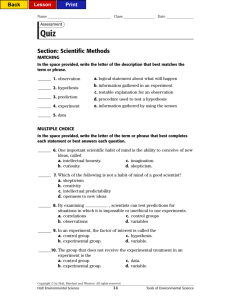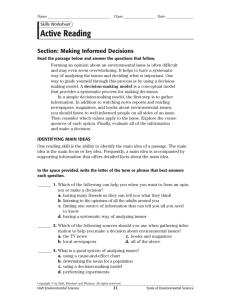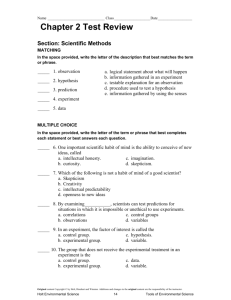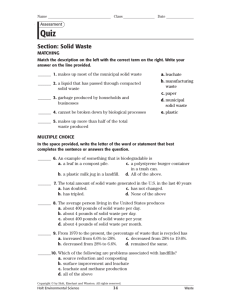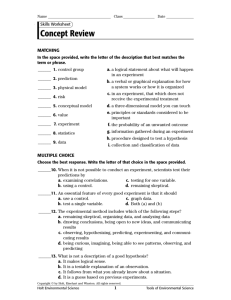Section: Making Informed Decisions
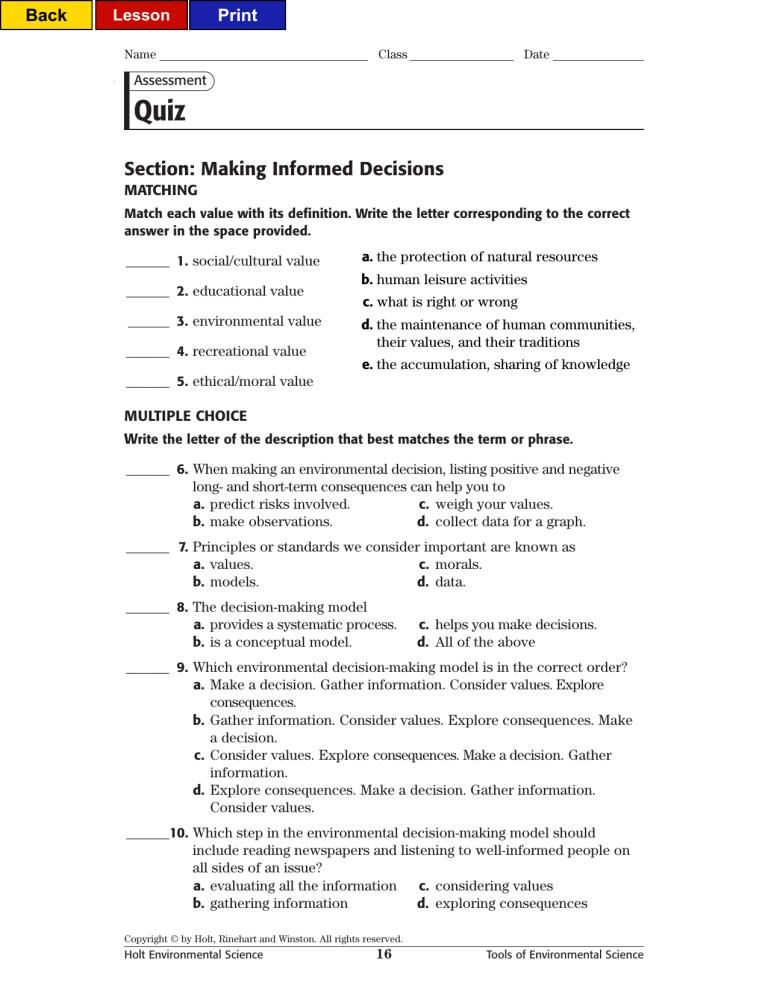
Back
Lesson
Name
Assessment
Quiz
Class Date
Section: Making Informed Decisions
MATCHING
Match each value with its definition. Write the letter corresponding to the correct answer in the space provided.
______ 1.
social/cultural value
______ 2.
educational value
______ 3.
environmental value
______ 4.
recreational value a.
the protection of natural resources b.
human leisure activities c.
what is right or wrong d.
the maintenance of human communities, their values, and their traditions e.
the accumulation, sharing of knowledge
______ 5.
ethical/moral value
MULTIPLE CHOICE
W rite the letter of the description that best matches the term or phrase.
______ 6.
When making an environmental decision, listing positive and negative long- and short-term consequences can help you to a.
b.
predict risks involved.
make observations.
c.
d.
weigh your values.
collect data for a graph.
______ 7.
Principles or standards we consider important are known as a.
b.
values.
models.
c.
d.
morals.
data.
______ 8.
The decision-making model a.
b.
provides a systematic process.
c.
helps you make decisions.
is a conceptual model.
d.
All of the above
______ 9.
Which environmental decision-making model is in the correct order?
a.
Make a decision. Gather information. Consider values. Explore consequences.
b.
Gather information. Consider values. Explore consequences. Make a decision.
c.
Consider values. Explore consequences. Make a decision. Gather information.
d.
Explore consequences. Make a decision. Gather information.
Consider values.
______ 10.
Which step in the environmental decision-making model should include reading newspapers and listening to well-informed people on all sides of an issue?
a.
b.
evaluating all the information gathering information c.
d.
considering values exploring consequences
Copyright © by Holt, Rinehart and Winston. All rights reserved.
Holt Environmental Science 16 Tools of Environmental Science
Back
Lesson Print
TEACHER RESOURCE PAGE
Active Reading
SECTION: SCIENTIFIC METHODS
1.
A single variable is tested; a control is used.
2.
They study two groups or situations at a time.
3.
to pinpoint cause and effect relationships
4.
control group
5.
experimental group
6.
everything except the variable being studied
7.
the level of phosphate in the water
8.
a
9.
Using both helps determine whether or not a hypothesis is correct.
10.
Phosphate in the water is killing the mussels.
SECTION: STATISTICS AND MODELS
1.
Individuals in a population have different characteristics.
2.
by determining a mean
3.
by adding up the data for a given characteristic and dividing this sum by the number of individuals for which data was collected
4.
d
5.
c
6.
a
7.
4
8.
5
9.
2
10.
1
11.
3
12.
Answers may vary. Sample answer:
Scientists can easily compare different populations by comparing their means.
SECTION: MAKING INFORMED
DECISIONS
1.
d
2.
d
3.
c
4.
c
5.
to act on principles or standards we consider important
6.
a conceptual model that provides a systematic process for making decisions
7.
4
8.
3
9.
2
10.
5
11.
1
12.
Answers may vary but should include a reference to making informed decisions.
Map Skills
1.
maple-beech-birch; oak-hickory
2.
Answers may vary but students should notice a general northward migration of tree species.
3.
Answers may vary but students should conclude that if the maple tree population declines, this could destroy the maple syrup industry in
New England.
4.
Answers may vary but students should suggest further modeling and making first-hand observations of actual temperature change and species migration over time.
Quiz
SECTION: SCIENTIFIC METHODS
Matching
1.
e
Multiple Choice
6.
c
2.
c
3.
a
4.
d
5.
b
7.
c
8.
a
9.
d
10.
a
SECTION: STATISTICS AND MODELS
Matching Multiple Choice
1.
c
2.
b
3.
a
4.
a
5.
b
6.
b
7.
d
8.
d
9.
c
10.
a
SECTION: MAKING INFORMED
DECISIONS
Matching
1.
d
Multiple Choice
6.
c
2.
e
3.
a
4.
b
5.
c
7.
a
8.
d
9.
b
10.
b
Copyright © by Holt, Rinehart and Winston. All rights reserved.
Holt Environmental Science 94 Tools of Environmental Science
